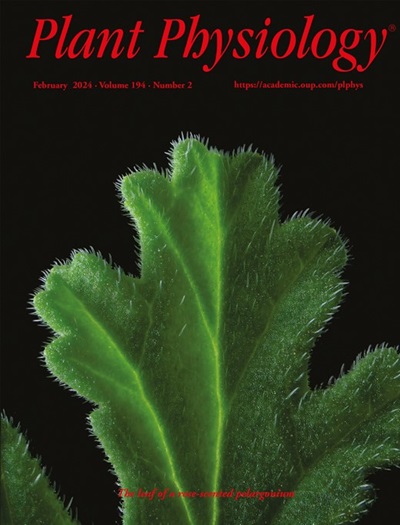The light-harvesting complex protein LHCB4 fine-tunes temperature-regulated flowering via chloroplast retrograde signaling in pear
IF 6.5
1区 生物学
Q1 PLANT SCIENCES
引用次数: 0
Abstract
Flowering is crucial for plant reproductive success and is regulated by both endogenous and external factors. However, the mechanisms by which ambient temperature influences flowering in pear (Pyrus spp.) remain poorly understood. In this study, we observed that elevated temperatures induce early flowering and alter the expression levels of pear light-harvesting complex Lhcb4 (PpyLhcb4) and other flowering-related genes. Notably, the heterologous expression of PpyLhcb4 in Arabidopsis increased chlorophyll content and delayed flowering under normal and high-temperature conditions, suggesting that PpyLhcb4 inhibits flowering by promoting chlorophyll biosynthesis. We also identified a base substitution (A to C) within the PpyLhcb4 promoter region in two pear varieties exhibiting different flowering times. This base substitution affected the CArG-box, which influences PpyLhcb4 promoter activity. Furthermore, the specific binding of the transcription factors PpyAP1 and PpyMADS1 to the PpyLhcb4 promoter was demonstrated. At 22 ℃, PpyLhcb4 expression was not regulated by AP1 but was inhibited by MADS1. However, at 30 ℃, both AP1 and MADS1 upregulated PpyLhcb4 expression. Moreover, we showed that PpyLHCB4 interacts with PpyPIF3 to sense environmental changes. In summary, this study elucidates the molecular mechanisms by which PpyLhcb4 regulates flowering, which involve an intracellular signaling pathway originating from the chloroplast that responds to environmental changes to balance plant growth and development.光收获复合蛋白LHCB4通过叶绿体逆行信号对梨的温度调节开花进行微调
开花是植物繁殖成功的关键,受内外因素共同调控。然而,环境温度影响梨花(Pyrus spp.)开花的机制仍然知之甚少。在本研究中,我们观察到高温诱导了梨提早开花,并改变了光收获复合体Lhcb4 (PpyLhcb4)和其他开花相关基因的表达水平。值得注意的是,在正常和高温条件下,PpyLhcb4在拟南芥中的异源表达增加了叶绿素含量,延迟了开花时间,表明PpyLhcb4通过促进叶绿素生物合成来抑制开花。我们还在两个开花时间不同的梨品种中发现了PpyLhcb4启动子区域的碱基替换(a到C)。这种碱基取代影响了CArG-box,从而影响了PpyLhcb4启动子的活性。此外,还证实了转录因子PpyAP1和PpyMADS1与PpyLhcb4启动子的特异性结合。在22℃时,PpyLhcb4的表达不受AP1的调控,而受MADS1的抑制。而在30℃时,AP1和MADS1均上调PpyLhcb4的表达。此外,我们发现PpyLHCB4与PpyPIF3相互作用以感知环境变化。综上所述,本研究阐明了PpyLhcb4调控开花的分子机制,该机制涉及一条源自叶绿体的细胞内信号通路,该通路响应环境变化以平衡植物的生长和发育。
本文章由计算机程序翻译,如有差异,请以英文原文为准。
求助全文
约1分钟内获得全文
求助全文
来源期刊

Plant Physiology
生物-植物科学
CiteScore
12.20
自引率
5.40%
发文量
535
审稿时长
2.3 months
期刊介绍:
Plant Physiology® is a distinguished and highly respected journal with a rich history dating back to its establishment in 1926. It stands as a leading international publication in the field of plant biology, covering a comprehensive range of topics from the molecular and structural aspects of plant life to systems biology and ecophysiology. Recognized as the most highly cited journal in plant sciences, Plant Physiology® is a testament to its commitment to excellence and the dissemination of groundbreaking research.
As the official publication of the American Society of Plant Biologists, Plant Physiology® upholds rigorous peer-review standards, ensuring that the scientific community receives the highest quality research. The journal releases 12 issues annually, providing a steady stream of new findings and insights to its readership.
 求助内容:
求助内容: 应助结果提醒方式:
应助结果提醒方式:


